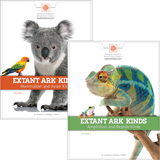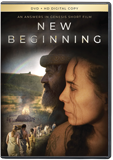
One of a Kind?
Forget evolution’s tree of life. God made an entire orchard of “kinds” all at once.
In the classic film The Wizard of Oz, Dorothy and her comrades wander through the dark forest chanting, “Lions and tigers and bears, oh my!”
If we used a similar phrase to describe the animals on Noah’s ark, we would say, “The cat kind and the bear kind, oh my!” Not quite as catchy but biblically and scientifically accurate. Since the lion and tiger both belong to the cat kind, we would see only two members of their kind going on the ark along with two members of the bear kind.
For over a century, creation scientists have asked, “What is a kind?” This question took on new importance when I joined a team of scientists helping to develop the Ark Encounter attraction in Northern Kentucky.
Biblical Definition of Kind
The word kind is used nearly 20 times in Genesis 1, 6, and 7, referencing both plants and animals. These organisms were created “according to their kind” (Genesis 1:11–12, 21, 24–25). The Hebrew word for kind is min, meaning subdivisions within a larger group. A plain reading of the text indicates that plants and animals were created to reproduce within the boundaries of their kind. A good rule of thumb is that if two things can breed together and produce offspring, they are members of the same created kind.
God spoke the plant and animal kinds into existence by his Word alone approximately 6,000 years ago (Genesis 1:11, 20, 24). Evolutionary ideas propose just the opposite, that creatures evolved slowly over millions of years by random chance. But reproduction occurs only within kinds, so one kind did not evolve into a different kind. For example, many evolutionists believe that dinosaurs haven’t died out but instead are now represented by modern birds. This is not possible from a biblical creation perspective since dinosaurs and birds are distinctive kinds and since there is no genetic mechanism to provide the information for novel traits necessary to make evolution happen (such as dinosaurs gaining feathers to become birds).
God also commanded Noah to take the animals aboard the ark “according to their kind” (Genesis 6:20, 7:14). Since reproduction after the flood would be essential to replenish the earth, Noah was instructed to take at least one male and one female of each kind (Genesis 6:19).
Scientific Definition of Kind
Many modern scientists use a system of classification first formulated by creation scientist Carl Linnaeus in the 1700s. If I told you, “King Philip Came Over From Great Spain,” you might recognize it as a mnemonic device for remembering the classification system Linnaeus developed: Kingdom, Phylum, Class, Order, Family, Genus, Species. Most biblical creationists believe that kind generally equates with the family level in this classification scheme.
Creation scientists refer to kinds more technically as baramins. The Hebrew word bara means “create” and min means “kind”; so a baramin is a created kind. The study of created kinds is baraminology. Baraminologists seek to categorize into respective baramins the animals that are living and the organisms known only from the fossil record.
When several other scientists and I began to research how many animals were on the ark, we needed to classify all living and fossil animals into their respective kinds. To define a kind, we used two primary criteria: hybridization and cognitum.
Hybridization occurs when two organisms of different species or genera mate with one another and produce offspring (like the zebra [Equus quagga] and the horse [Equus ferus] mating to produce a zorse). This fits well with the biblical inference that kind is a reproductive unit. If two organisms reproduce, they are definitely members of the same kind. However, this does have limitations. Some members of the same kind may no longer be able to mate and produce offspring due to genetic mutations that occurred after the fall. In addition, hybridization data is not available for animals in the wild and obviously isn’t a valid criterion for extinct organisms.
Cognitum is a term to describe how the human cognitive senses naturally group organisms. For example, you could easily separate kangaroos, squirrels, and rabbits into three groups based on their physical similarities and differences, even if you were unfamiliar with the animals. Kinds have remained distinct even as they have diversified into different species. Our cognitum is very strong for sorting organisms at the family level (for example, horses, zebras, and donkeys).
Using these criteria, we determined that approximately 1,400 animal kinds were on the ark. These animal kinds left the ark, reproduced, and refilled the earth after the flood (Genesis 8:17). Though we observe multiple species and varieties within kinds, we never observe one kind evolving into a different kind. Instead of an evolutionary tree of life, we observe a creation orchard of God’s created kinds with variation occurring only within those kinds. Science once again confirms God’s Word.
What About Mankind?
Since God created multiple plant and animal kinds, it’s logical to ask whether he created multiple human kinds. Do neanderthal people represent a different kind? Are all the different ethnicities around the world separate created kinds? The answer to these questions is no. God created man and woman, Adam and Eve, and commanded them to multiply and fill the earth (Genesis 1:26–28). Adam named his wife Eve because “she was the mother of all living” (Genesis 3:20). All people, no matter the size of their eyebrow ridge, shade of their skin, or shape of their eyes (which are really just minor variations anyway), come from this original pair of humans.
Humans are distinct from animals because they are the only creatures made in the image of God (Genesis 1:27). Although Adam and Eve chose to sin (Genesis 3), resulting in our sin nature, God in his great mercy sent his Son, Jesus, to die for his now-sinful image bearers. Now we have the opportunity of a restored relationship with him.
Just as our sin nature started with the first Adam in Genesis, the solution to sin is in the last Adam, Jesus Christ (Romans 5:15; 1 Corinthians 15:21–22). Scripture is clear that humankind is the crowning glory of creation and is the most important “kind” of all.
Answers Magazine
July–August 2019
When we consider fossils and extinct creatures, the ark surely contained many animals we would not normally consider. What animals were—and weren’t—on the ark?
Browse IssueRecommended Resources

Answers in Genesis is an apologetics ministry, dedicated to helping Christians defend their faith and proclaim the good news of Jesus Christ.
- Customer Service 800.778.3390
- Available Monday–Friday | 9 AM–5 PM ET
- © 2025 Answers in Genesis




